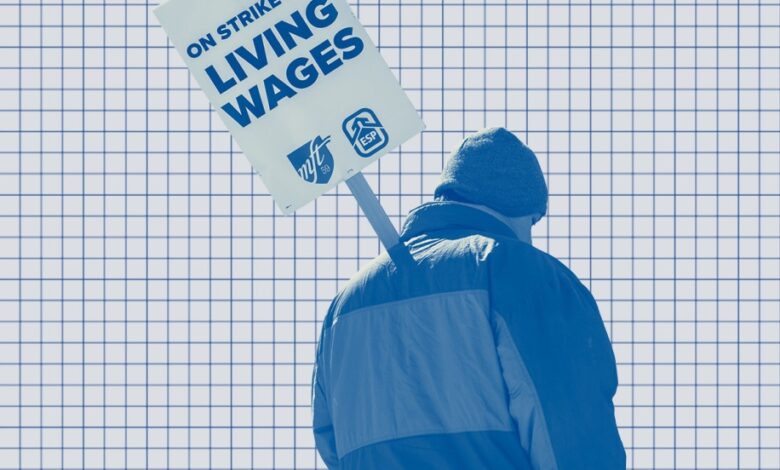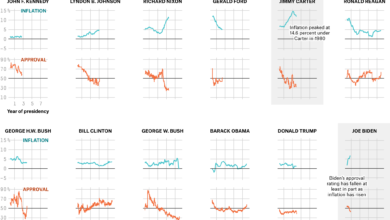Americans Generally Support Unions — And Averting A Rail Strike

Americans Generally Support Unions — And Averting A Rail Strike
PHOTO ILLUSTRATION BY FIVETHIRTYEIGHT / GETTY IMAGES
When President Biden signed a bill to prevent a rail-worker strike this past Friday, it was only the latest in a series of union actions that have gotten national attention in the past few years. Starbucks and Amazon workers are trying to unionize around the country. Nationwide, 78,000 workers went on strike in the first half of the year. Members of The New York Times Guild walked out on Thursday.
The National Labor Relations Board reported a 57 percent increase in the number of union elections in the first half of the 2022 fiscal year — Oct. 1, 2021, through March 31 this year — and unions are winning more than three quarters of their votes. And the share of Americans who support unions, 71 percent, is at the highest level since 1965, according to Gallup. After a decades-long slump, organized labor is on the upswing.
Some of this undoubtedly results from the tumult in workplaces throughout the COVID-19 pandemic. First, essential workers who couldn’t stay home banded together to demand more safety measures in the months when the virus was new and vaccines weren’t yet available. Then, as workplaces and the country began reopening, unemployment plummeted and has stayed low. Despite some recent mass layoffs, especially in tech and journalism, the labor market is so far mostly defying fears of a recession and ignoring the Federal Reserve’s efforts to tame it. That has put workers in a relatively powerful position, at least up to now.
Workers have recently undertaken everything from work stoppages to strikes for better pay and working conditions, according to data from the IRL Worker Institute at Cornell University. The institute has seen a “noticeable uptick” in union activity this year compared with the previous year, according to Johnnie Kallas, a Ph.D. candidate who is the project director of the IRL Worker Institute’s Labor Action Tracker. But it’s hard to know how that compares with the past. Because of budget cuts in the Reagan era, the Bureau of Labor Statistics stopped tracking all but the biggest labor actions. It’s also unclear if recent labor actions will translate into long-term change for workplaces, unions and the workers they represent.
For most of the time since the 1930s, a majority of Americans have favored labor unions, but support began to decline in the 1960s, dropping from 71 percent in 1965 to 55 percent by 1979. After a slight increase, Americans’ support of unions hit a low of 48 percent in 2009. The share of private-sector workers in unions also declined steadily since the 1980s. This was caused by a multitude of political and economic factors — industrial deregulation, the rise of anti-union politicians, increasing globalization — but American workplaces also fundamentally changed. Employment opportunities moved from traditionally organized workplaces, like factories, into a service industry where union density was already lower. Many workers unionizing today are making coffee instead of cars, and issues like high turnover and irregular worker schedules in those industries led to job instability.
Support for unions today is also divided along partisan lines: Sixty-five percent of Democrats and 43 percent of independents support unions, while a plurality of Republicans (47 percent) oppose them, according to CivicScience. That being said, a majority of Americans think that whether to unionize should be entirely the workers’ choice and that employers should stay neutral.
And despite the partisanship, Americans largely favor the kinds of worker protections and benefits unions fight for. In general, Americans think businesses should treat workers with respect, pay fair wages and provide health care benefits. Sixty-two percent of Americans support a $15 federal minimum wage, and three-quarters of Americans think the current federal minimum wage, $7.25 an hour, is too low. Americans strongly support paid family and medical leave, a sticking point in the rail-worker negotiations. While the pandemic led to more states and cities mandating paid sick leave and 79 percent of civilian workers had paid leave available to them as of March 2021, the workers least likely to have it are the lowest paid.
But all of that general support didn’t carry over to the specific case of the rail workers and their requests for paid sick leave to be included in their contract. CivicScience found that 68 percent of Americans approve of Biden blocking the rail strike. A poll from The Economist/YouGov conducted Dec. 3-6 found that 56 percent of Americans approve of government action to avoid a strike that could harm the American economy, suggesting that supply-chain concerns in the middle of the holiday shopping season might have outweighed sympathy to the rail workers’ demands. But rail workers have warned that more disgruntled employees could bail on an industry that is already understaffed. That has been the overall story of how workers in all kinds of industries have flexed their power in the labor market over the past few years, whether or not they personally have a union to back them up. If conditions and pay at one job don’t meet workers’ expectations, many have had an easier time finding a job that does.
Other polling bites
Americans are more likely than citizens of other countries to be wary of social media’s role in politics, according to polling conducted in 19 different nations and recently published by Pew Research Center. Sixty-four percent of Americans said that social media has had a negative impact on democracy — a percentage higher than that of any other country surveyed, which ranged from 54 percent in the Netherlands down to 15 percent in Poland. Despite their concerns about social media, Americans’ usage has risen over the past ten years: Seventy-two percent of American adults use such sites today, versus just 50 percent in 2012. All in all, this is not so different from places where social media is viewed as less threatening to democracy. Sixty-six percent of Polish citizens, for example, use social media now, up from 40 percent a decade ago. (In 2012, Pew asked the social-media-usage question only of people who first reported they used the internet, whereas in 2022 that question was asked of all respondents.)Americans were more confident that their 2022 midterm-election ballot was counted accurately than they were that their 2020 presidential-election ballot was, per Nov. 17-21 polling from Navigator Research. Sixty percent of Americans believed their 2020 ballots were counted correctly and fairly, versus 71 percent who said the same about 2022. The level of confidence reported by Democrats and independents remained virtually the same across the two elections, but the same did not hold true for Republicans: While only 31 percent felt their 2020 ballot was correctly counted, nearly double (58 percent) voiced the same about their 2022 ballot.Gun ownership in America varies widely by gender, according to recently released Gallup polling. Just 22 percent of American women reported personally owning a gun, but that rate is nearly double among men (43 percent). Men’s gun ownership levels have remained fairly consistent since 2007, according to annual surveys from Gallup, while the number among women has risen slightly from 13 percent in the organization’s first poll on the matter, conducted in 2007-2008. A Nov. 18-22 survey from Data For Progress found that more than two-thirds of Americans (69 percent) were at least somewhat worried climate change will lead to higher consumer prices in the future. High numbers of Democrats were worried about the impact of climate change on prices (82 percent), but 56 percent of Republicans also share these concerns. That said, there’s less consensus on what to do about it. Almost half of Democrats (45 percent), for example, said that renewable energy production will bring down energy costs “a lot,” yet only 12 percent of Republicans were on the same page.
Biden approval
According to FiveThirtyEight’s presidential approval tracker,1 42.1 percent of Americans approve of the job Biden is doing as president, while 52.6 percent disapprove (a net approval rating of -10.5 points). At this time last week, 41.4 percent approved and 53.2 percent disapproved (a net approval rating of -11.7 points). One month ago, Biden had an approval rating of 41.4 percent and a disapproval rating of 53.5 percent, for a net approval rating of -12.1 points.





